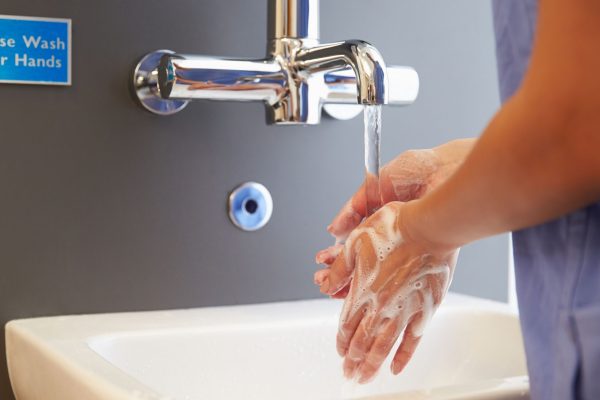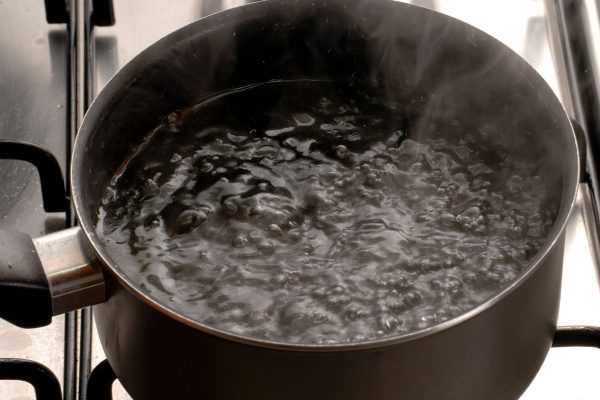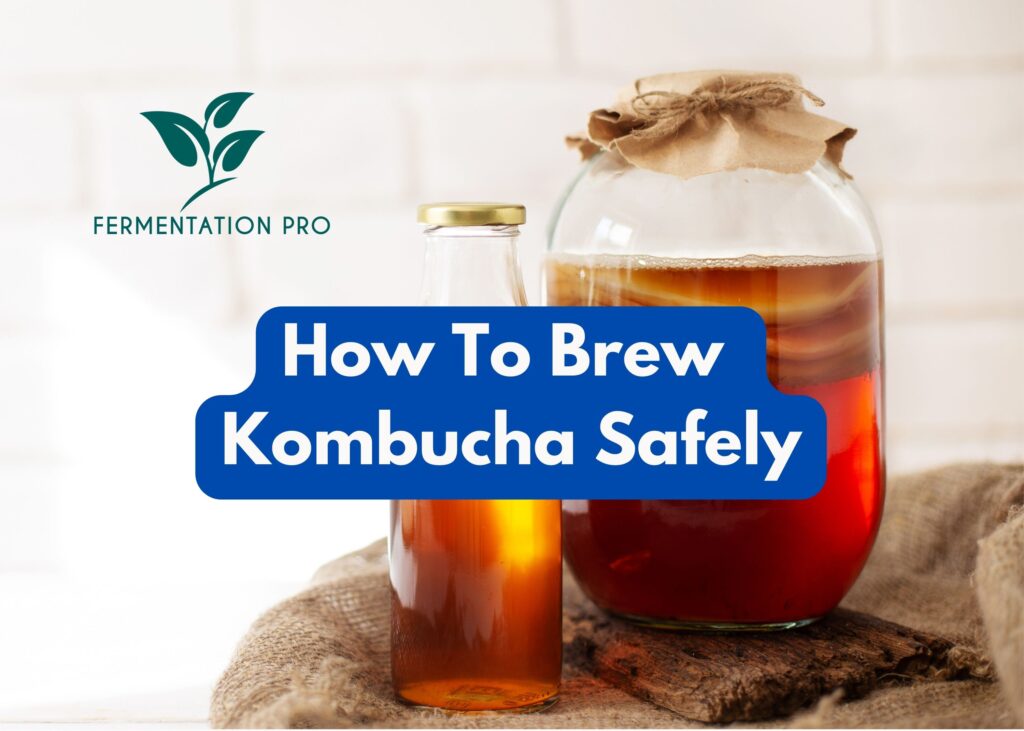Everyone who brews Kombucha knows that even if Kombucha can produce a natural defense against contamination, it is still not completely safe against molds, fungus, wild bacteria and yeasts, and fruit flies. If you’re wondering, how to brew Kombucha safely, this post has all the most important answers.
Brewing Kombucha safely starts with cleanliness. Always make sure to only use clean fermentation tools and equipment for your brew and keep your Kombucha in a clean fermentation station away from trash, plants, and other things that can contaminate it. In addition to that, make sure to keep your Kombucha at the ideal brewing temperature to keep your culture healthy and active so it can produce enough acidity to protect the brew from contaminants. The natural acidity of Kombucha provides a line of defense against the growth of harmful microbes.
Ultimately, Kombucha is a great homebrewing project to make, but like other fermented projects, Kombucha is still prone to infestations that can cause harm to the brew and the health of the drinker. To help you brew Kombucha safely at home. Here is the complete list of what you should do.
Table of Contents
How To Brew Kombucha Safely

- Always wash your hands when handling the SCOBY pellicle
The hands can house harmful microbes that can interact with the culture of yeast and bacteria in the SCOBY pellicle hence it is always best to clean your hands when holding it. To clean your hands properly, only use filtered water or Kombucha liquid.
- Keep your fermentation station clean
Airborne spores of bacteria or fungus can stay on different surfaces including the kitchen counter. Hence, when brewing Kombucha always make sure that the Kombucha brewing vessel is in a clean fermentation station To clean your fermentation station, you can use Kombucha liquid or vinegar.
- Always clean your brewing tools and equipment
Tools and equipment that will have direct contact with your brew should be clean to prevent any bacteria from sneaking into your brew. You can use Kombucha liquid or hot water to clean them.
You may also use distilled vinegar to clean your brewing tools. Avoid using raw vinegar in cleaning Kombucha tools as the acidic compounds in the vinegar could come into contact with the Kombucha SCOBY and transform it into a vinegar culture. In addition, avoid chlorine-based cleaners as chlorine can kill the bacteria in the SCOBY. Soaps, particularly antibacterial soaps, can also harm the bacteria in Kombucha so it’s best to avoid using them.
- Only use vessels that are suitable for fermenting Kombucha
The best vessels for storing your Kombucha during fermentation are the following.
- Glass
- Stainless steel (grade 304 or higher) jar
- Food-grade porcelain/stoneware
- Wooden barrel
These vessels are the safest to use as they do not react to the acidity of the Kombucha. Moreover, they don’t contain chemicals such as BPA that can leach into the brew and raise health concerns.
Keep in mind to avoid using fermentation vessels that can react to the acidity of the Kombucha and can leach toxic chemicals into the brew. The following are the vessels that are not suitable for brewing Kombucha.
- Plastic containers
- Crystal jars
- Decorative ceramic jars
- Metal vessels that are not made of stainless steel
During the second fermentation, you may use plastic bottles as Kombucha’s acidity reduce to safe levels after bottling.
- Brew with filtered or purified water
Always use filtered or purified water when making your Kombucha sweet tea. Do not use water treated with chlorine as the chlorine may kill the bacteria in the SCOBY. You may use tap water as long as it is not treated with chlorine and is boiled properly.

Best Ingredients for Brewing Kombucha
- Brew with the right ingredients
The right ingredients can keep the Kombucha culture well-fed and healthy. Using the right ingredients also allows the Kombucha culture to grow thick faster. Using ingredients that are not appropriate for Kombucha can make the Kombucha culture unhealthy. With an unhealthy culture, the Kombucha will not ferment properly and will not develop enough acidity to protect the brew from harmful microorganisms.
Below we list the best ingredients to use in Kombucha. We also mentioned the ingredients you need to avoid.
- True tea leaves
Only use true tea leaves like black, green, white, and oolong tea when making sweet tea for the Kombucha. These teas are not just loaded with health benefits but can also provide fuel for the SCOBY to grow.
Avoid herbal teas like peppermint or chamomile as they do not have enough nutrients to aid in the growth of the culture. While you can’t use herbal teas as a tea base for Kombucha, you may use them to flavor it during the second fermentation.
- Cane sugar
Cane sugar, widely referred to as white sugar, remains to be the best and most commonly used sugar for brewing Kombucha. It is cost-effective and can provide sufficient sucrose to boost culture activity. Nowadays, many brewers also experiment with different kinds of sugar such as the following:
- Turbinado
- Muscovado
- Molasses
- Maple syrup
- Agave
- Coconut palm sugar
You may also use honey as a sucrose source for the Kombucha culture. However, do not use raw honey as it may house microorganisms that can interact with the bacteria culture in the Kombucha ferment.
Take note that even if you can use the sugars mentioned above, the results of using them are different. If you are new to brewing Kombucha, we recommend sticking to cane sugar as it produces more consistent results.
Avoid using sugar substitutes or artificial sweeteners that are not fermentable by yeast. These sugars will not provide any food for the Kombucha culture leading to their poor health and failure to brew Kombucha. Some of the common sugar substitutes you have to avoid are:
- Stevia
- Xylitol
- Erythritol

Other Brewing Techniques for Kombucha
- Cover the Kombucha brewing vessel with a cloth cover or coffee filter
Cloth cover and coffee filter are breathable materials that can allow good airflow that is necessary for keeping the Kombucha culture healthy. At the same time, they have small holes that can block any insects from entering the brew. Avoid using cheesecloth as it has relatively large holes where insects and flies can enter.
Don’t forget to secure the cover with a rubber band to prevent it from falling. Make sure to keep the cover of the Kombucha secure all the time to protect it against mold, impurities, and insects.
- Consider the location of your fermentation station
Temperature and airflow are important during the first fermentation. The bacteria in the Kombucha need oxygen to stay healthy and active, hence keeping the Kombucha in a place with good airflow can help keep the culture healthy and efficient for fermentation.
In addition to airflow, a warm temperature is needed to maintain culture health and encourage fermentation. While a warm temperature is recommended for fermenting Kombucha, take note that the brewing vessel should not be kept under direct sunlight. Doing so can cause inconsistent temperatures that can affect the culture’s health.
It is best to keep Kombucha in a closed location like the cupboard or use a Kombucha brewing sleeve to prevent light from affecting the temperature of your brew. Keep in mind that the Kombucha culture’s health is dependent on consistent temperature. When the culture is happy and active, it can produce acidity that can protect Kombucha from microbes that can cause contamination.
- Avoid disturbing the Kombucha during fermentation.
Moving the vessel or stirring the Kombucha too much during its fermentation can prevent the culture from forming and working properly. When this happens, they will not be able to ferment properly and produce necessary byproducts that keep Kombucha safe.
- Use a strong starter liquid
A strong starter liquid can give Kombucha a jumpstart in the fermentation progress and acidity development. You can use the liquid from your previous batch of Kombucha ferment or buy from a local health store.
- Store your SCOBYs in a SCOBY hotel
SCOBYs play the most important role in keeping the Kombucha safe from contamination. They are responsible for producing the acidic properties of Kombucha that protect it from potential contaminants. Hence, it’s important to properly store them to keep them healthy and active. The best way to store SCOBYs is by keeping them in a SCOBY hotel. A SCOBY hotel provides a safe place for your SCOBY to stay healthy and active while you take a break from brewing.
Some brewers opt to keep their SCOBYs in the fridge when they are not in use, however, we cannot recommend it as the cold temperature can make the Kombucha culture dormant and inactive.
- Throw away batch that gets mold
Throwing a batch that gets mold feels like a waste, but it is a must. Mold produces toxic chemicals called mycotoxins that can cause disease and even death depending on the person’s health and age. Some common side effects of drinking moldy Kombucha are vomiting and diarrhea. Molds have a circular and fuzzy or dry appearance. Their colors range from white, green, black, or blue.
Below, we list the most common reasons why Kombucha develops molds.
- Brewing Kombucha at a cold temperature
- Not using enough or strong starter tea
- Using brewing unclean brewing tools and equipment
- Using the wrong ingredients
- Choosing the wrong place for fermentation








